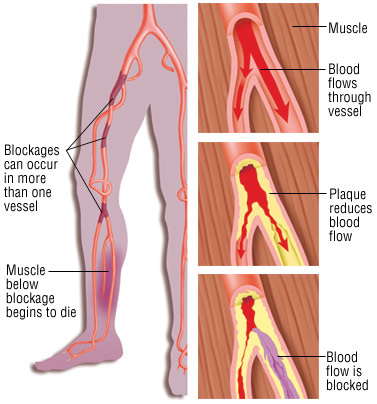Peripheral Vascular Intervention
Peripheral Vascular Intervention
Peripheral vascular interventions are required for patients suffering from significant hardening of arteries or atherosclerosis. Their arteries are partially blocked by plaque and when these blockages occur in the arms or legs, they are termed peripheral artery disease. Peripheral vascular interventions are necessitated to remove the plaque and restore blood supply through them.
A small nick in the arm or the leg is made to insert a catheter; which is a small tube that is inserted into the blood vessel and threaded to the site of the disease. Once it is in place, it starts acting as a tunnel facilitating the doctor to efficiently guide the tools to where they are needed.
The muscles and other tissues of the arms and legs need oxygen and nutrients to work. If the arteries that feed the arm or leg are blocked by plaque (a mixture of cholesterol, fat, calcium and other substances), the leg will not work well and may experience pain or numbness. In extreme circumstances, they may require amputation. By using a catheter, doctors avoid making large surgical cuts when they remove the blockage. As a result, procedures that rely on a catheter generally decrease pain, pose less risk of infection, avoid large scars and shorten recovery times. In some cases, the patient may go home the same day.

In angioplasty, the doctor uses a catheter to guide a small, unfilled balloon to the site of the blockage. The balloon is inflated, pressing the plaque tight against the wall of the artery. After the balloon is removed, the opening in the artery is wider, and blood can flow more freely to the heart muscles.
After angioplasty, the catheter may be used to place a small mesh tube, called a stent, into the site of the blockage. The stent works to keep the plaque packed against the wall of the blood vessel and the artery propped open.
In this procedure, the doctor removes the plaque from the artery. Using a catheter, the doctor directs a very small device with tiny blades that can precisely shave the plaque from the artery wall while safely collecting it. In some cases, the doctor may use a tiny laser that blasts the plaque into small pieces that dissolve in the blood. One advantage of these approaches is that no medical device is left in the body after the completion of the procedure.
During a peripheral vascular intervention, you will have anesthesia, so the discomfort and pain will be minor. It may be a local anesthetic, so you won’t feel much discomfort where the doctor will insert the catheter into your groin or arm. You’ll remain awake and be able to follow the doctor’s instructions. In other cases, you may get a general anesthetic, so you will not be awake during the procedure.
These procedures generally can take between 30 minutes to several hours. You’ll remain on your back throughout the procedure.
After the procedure, you may stay in the hospital for one to two days to allow you to safely recover. If your procedure is performed early in the day and you are recovering well, you may be allowed to go home the same day.
Possible side effects include allergic reactions to some of the medicines and dyes used during the procedure. Dye can also cause kidney damage if you have some underlying kidney disease. As with all operations, bleeding and infection are risks. Other risks include loss of limb, brain damage, heart attack, strokes and more blockage of the artery over time.
